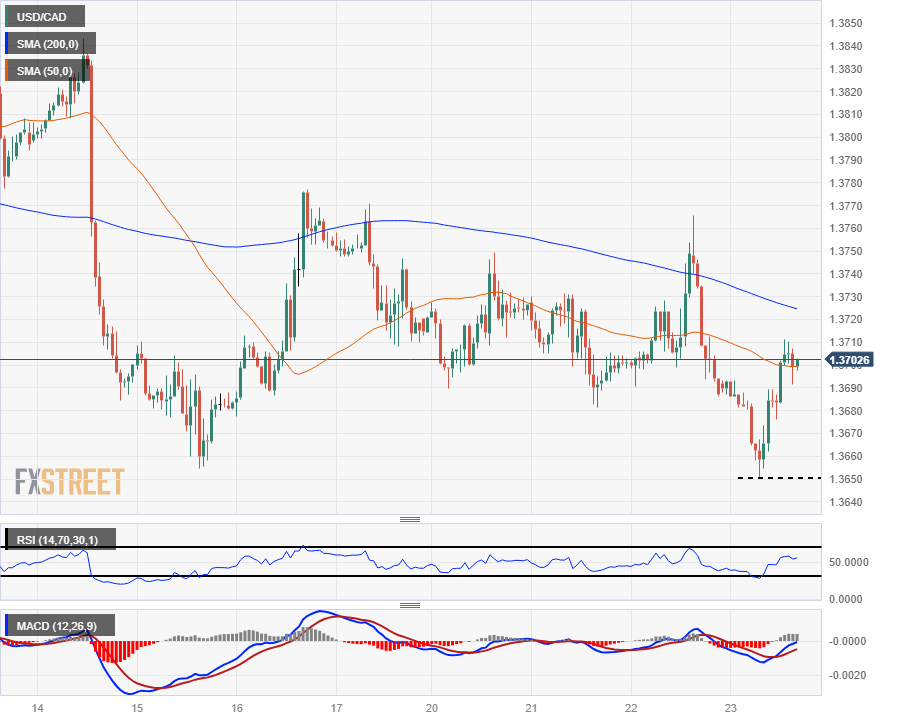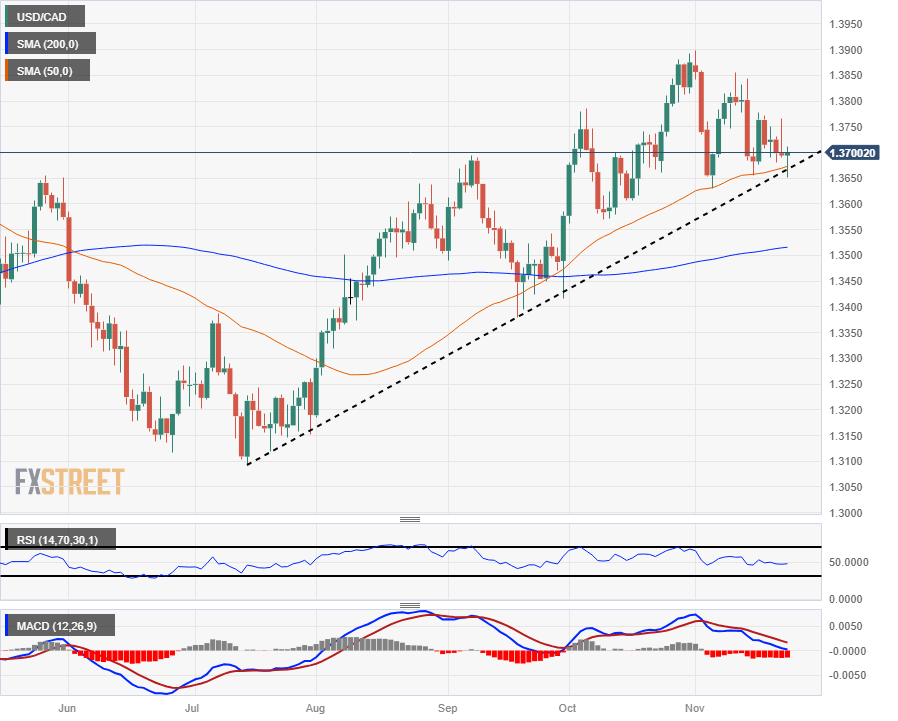Canadian Dollar treads water with US markets out for Thanksgiving holiday

- The Canadian Dollar is catching a breather as the Loonie market goes flat.
- Friday’s Canada Retail Sales to be overshadowed by US PMIs.
- Thursday set to be a quiet session with the US out for Thanksgiving.
The Canadian Dollar (CAD) is holding steady on Thursday, with the USD/CAD trading closely with the day’s opening bids. Friday will see US equity markets return to the fold for a reduced trading day before shutting down again for the weekend.
Friday will also see the latest round of Retail Sales from Canada, but the release is likely to be overshadowed by the US Purchasing Managers’ Index (PMI) release.
Daily Digest Market Movers: Canadian Dollar flatlines, capped by soft Crude Oil bids
- The CAD is grinding into the middle as US holiday trading volumes deflate market momentum.
- The Loonie initially kicked higher on the day but quickly fell back to Thursday’s opening bids.
- Crude Oil is seeing some downside play, limiting CAD support.
- In a speech on Wednesday, Bank of Canada (BoC) Governor Tiff Macklem highlighted that BoC policymakers “might” have done enough to tame inflation, balance economy.
- Friday’s CAD Retail Sales to have limited impact as traders focus on US PMIs.
- Median market forecasts are expecting flat results or slight declines in both data sets.
- CAD Retail Sales in September expected to print 0.0%, previous -0.1%.
- Retail Sales Excluding Vehicles is expected to reveal a -0.2% decline in consumption spending.
- US November PMIs are forecast to decline in both the Services and Manufacturing components.
- Services are forecast to tick lower from 50.6 to 50.4, while Manufacturing is expected to fall into contractionary territory at 49.8 versus October’s 50.0.
Canadian Dollar price this week
The table below shows the percentage change of Canadian Dollar (CAD) against listed major currencies this week. Canadian Dollar was the strongest against the US Dollar.
| USD | EUR | GBP | CAD | AUD | JPY | NZD | CHF | |
| USD | 0.00% | -0.65% | -0.17% | -0.76% | -0.25% | -0.86% | -0.28% | |
| EUR | 0.00% | -0.67% | -0.17% | -0.76% | -0.25% | -0.86% | -0.26% | |
| GBP | 0.65% | 0.66% | 0.51% | -0.09% | 0.42% | -0.19% | 0.38% | |
| CAD | 0.17% | 0.17% | -0.49% | -0.57% | -0.07% | -0.69% | -0.10% | |
| AUD | 0.74% | 0.75% | 0.10% | 0.58% | 0.51% | -0.10% | 0.49% | |
| JPY | 0.24% | 0.24% | -0.66% | 0.07% | -0.52% | -0.62% | -0.04% | |
| NZD | 0.87% | 0.86% | 0.21% | 0.69% | 0.10% | 0.61% | 0.58% | |
| CHF | 0.28% | 0.28% | -0.37% | 0.11% | -0.47% | 0.03% | -0.58% |
The heat map shows percentage changes of major currencies against each other. The base currency is picked from the left column, while the quote currency is picked from the top row. For example, if you pick the Euro from the left column and move along the horizontal line to the Japanese Yen, the percentage change displayed in the box will represent EUR (base)/JPY (quote).
Technical Analysis: Canadian Dollar holds steady, USD/CAD goes flat near 1.3700
The Canadian Dollar (CAD) is losing all momentum on Thursday, trading closely with the day’s opening bids of 1.3700 against the US Dollar (USD). The USD/CAD briefly fell into a new low for the week as the Loonie found some bidding (or the Greenback just lost some steam), but a slight softening in Crude Oil bids is pulling the CAD back into the day’s starting gate.
The USD/CAD briefly dipped into 1.3650 before getting pushed back into near-term median bids at the 50-hour Simple Moving Average (SMA). Intraday action continues to see constraint from the 200-hour SMA declining into 1.3720.
On the daily candlesticks, Thursday’s bounce back into 1.3700 makes more sense following a rebound from the 50-day SMA, and technicals are lining up for a slow grind with technical support from the 50 and 200-day SMAs at 1.3670 and 1.3512, respectively.
Technical indicators are leaning into the midrange as momentum leaks out of the USD/CAD chart in the medium term. The Relative Strength Index (RSI) is drifting around the 50.0 middle level, while the Moving Average Convergence Divergence (MACD) has multiple levels of moving averages constraining it into the zero threshold, indicating an overall lack of strength in either direction.
USD/CAD Hourly Chart
USD/CAD Daily Chart

Risk sentiment FAQs
In the world of financial jargon the two widely used terms “risk-on” and “risk off” refer to the level of risk that investors are willing to stomach during the period referenced. In a “risk-on” market, investors are optimistic about the future and more willing to buy risky assets. In a “risk-off” market investors start to ‘play it safe’ because they are worried about the future, and therefore buy less risky assets that are more certain of bringing a return, even if it is relatively modest.
Typically, during periods of “risk-on”, stock markets will rise, most commodities – except Gold – will also gain in value, since they benefit from a positive growth outlook. The currencies of nations that are heavy commodity exporters strengthen because of increased demand, and Cryptocurrencies rise. In a “risk-off” market, Bonds go up – especially major government Bonds – Gold shines, and safe-haven currencies such as the Japanese Yen, Swiss Franc and US Dollar all benefit.
The Australian Dollar (AUD), the Canadian Dollar (CAD), the New Zealand Dollar (NZD) and minor FX like the Ruble (RUB) and the South African Rand (ZAR), all tend to rise in markets that are “risk-on”. This is because the economies of these currencies are heavily reliant on commodity exports for growth, and commodities tend to rise in price during risk-on periods. This is because investors foresee greater demand for raw materials in the future due to heightened economic activity.
The major currencies that tend to rise during periods of “risk-off” are the US Dollar (USD), the Japanese Yen (JPY) and the Swiss Franc (CHF). The US Dollar, because it is the world’s reserve currency, and because in times of crisis investors buy US government debt, which is seen as safe because the largest economy in the world is unlikely to default. The Yen, from increased demand for Japanese government bonds, because a high proportion are held by domestic investors who are unlikely to dump them – even in a crisis. The Swiss Franc, because strict Swiss banking laws offer investors enhanced capital protection.
